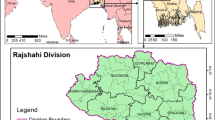Abstract
This study attempts to identify and classify the 87 districts of Papua New Guinea by their levels of development. With the aid of factor analysis applied to 30 elementary indicators, six major dimensions or features associated with development are uncovered. The factor scores of the more important features (education status, urbanization, nutrition status) are mapped. Various measures are used to compute the overall status of a district. Next cluster analysis is used to classify districts on the basis of their similarity on certain combinations of attributes. Comments are made on the agricultural and urban sectors in the context of Papua New Guinea's first 5-year National Development Plan. A set of possible planning regions comprising the less developed districts is suggested.
Similar content being viewed by others
Bibliography
(IASER = Institute of Applied Social and Economic Research, Port Moresby, Papua New Guinea.)
Albuquerque, K. and D'Sa, E.: 1985, ‘Spatial inequalities in Papua New Guinea: A district level analysis’, IASER report to the National Planning Office, Port Moresby.
ApthorpeR.: 1977, ‘Social planning indicators and social reporting in Papua New Guinea’, UNRISD/77/c, 39, pp. 1–109.
Boutau, G., Brink, P. and King, D.: 1983, ‘1980 national population census: district level analysis’, Department of Geography and Demography, University of Papua New Guinea, typescript.
CantR. G.: 1976, ‘Territorial indicators and national planning’, in: The Use of Socioeconomic Indicators in Development Planning (UNESCO press, Paris).
Central Planning Office: 1973, Papua New Guinea's Improvement Plan 1973–1974 (Waigani).
Clunies Ross, A.: 1984, ‘Migrants from fifty villages’, IASER Monograph 21.
D'Sa, E.: 1985, ‘Provincial inequalities in Papua New Guinea’, Yagl-Ambu, (to appear).
Etherington, D. and Carrad, B.: 1983, ‘The appropriate scale for South Pacific agriculture’ (Waigani Seminar, University of Papua New Guinea).
F.A.O.: 1983, Interim Report: ‘Profile and planning study for subsistence food production’ (Port Moresby).
GumR., RoeesT. and KimballD.: 1976, ‘Quatifying societal goals: Development of a weighting methodology’, Water Resources Research 12, pp. 617–22
HartiganJ.: 1975, Clustering Algorithms (John Wiley, New York).
HeywoodP.: 1985, ‘The National Nutrition Survey: A preliminary district level analysis of length and weight data’, typescript, Papua New Guinea Institute of Medical Research, Madang.
HinchliffeK.: 1980, ‘Conflicts between national aims in Papua New Guinea: the case of decentralization and equality’, in Economic Development and Cultural Change, 28, pp. 819–38.
Horn, R. V.: 1979, ‘Indicators for socio-economic planning’, Paper presented at 49th ANZAAS Congress, Auckland, 1979.
Khan, H.: 1979, ‘Measuring socio-economic development: A cluster analytic approach’. Paper presented at 49th ANZAAS Congress, Auckland, 1979.
MayR. J. (ed.): 1977, Change and Movement: Readings on Internal Migration in Papua New Guinea (Australian National University Press, Canberra).
McGranahanD. V., Richard-ProustC., SovaniN. V. and SubramanianM.: 1972, Contents and Measurement of Socio-economic Development. UNRISD, Praeger, New York.
National Planning Office: 1982, National Public Expenditure Plan 1983–86 (Government printer, Port Moresby).
National Planning Office: 1984, Medium Term Development Strategy, Agriculture, Forestry and Fisheries Sectors. Discussion Papers, Waigani.
National Planning Office: 1985, Medium Term Development Strategy (Summary, Waigani).
Townsend, P. and Nou-Taboro, O.: 1984, ‘Mapping material and child health coverage in Papua New Guinea’, IASER, typescript.
TrotmanP. and RavusiroR.: 1984, ‘Employment and growth prospects in selected urban areas’. Working paper No 3. Department of Physical Planning and Environment, Boroko.
WilsonR. K.: 1975, ‘Socio-economic indicators applied to subdistricts of Papua New Guinea’, Yagl-Ambu, 2, pp. 71–87.
Author information
Authors and Affiliations
Rights and permissions
About this article
Cite this article
D'sa, E.R. Social indicators and spatial disparities in Papua New Guinea. Soc Indic Res 18, 285–319 (1986). https://doi.org/10.1007/BF00286622
Received:
Issue Date:
DOI: https://doi.org/10.1007/BF00286622




